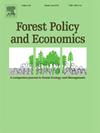Assessing the potential of the ‘typical forest enterprise approach’ for research in forest economics and application in policy making: A comparative analysis based on five national case studies
IF 3.8
2区 农林科学
Q1 ECONOMICS
引用次数: 0
Abstract
Small-scale private forest enterprises (SSPFEs) play an important role in the forest sector in many EU member states. However, unlike large-scale or publicly-owned forest enterprises, they are often not included in statistical surveys. This results in a lack of elementary basic economic data on wood production on SSPFEs, which is a prerequisite for effective policy implementation and impact assessment across the EU. To address this data gap, this pilot study examines the potential application of a modified “Typical Enterprise Approach” (TEA) to forestry for the first time for SSPFE in Austria, Finland, Germany, Slovenia, and Sweden. In the TEA, models of enterprises are constructed, reflecting the typical conditions and management practices in a specific region or country. For our study, extensive literature research and expert interviews were selected to identify typical companies and depict their wood production system with key performance indicators. Our findings show, that despite sharing EU membership and common political and legal frameworks, data availability, typical enterprise characterization and cost and revenue structures vary across the five countries. Notwithstanding further need of refinement, the TEA has the potential to serve as a key source for understanding different wood production systems and for providing socio-economic key figures. By providing comprehensive and consistent data from typical enterprises, a refined TEA can help to estimate the geographical variation, identify best practices and contribute to enhancing the sustainability of SSPFEs. Therefore, a permanent establishment of an international TEA network in forestry would be highly beneficial.
评估“典型森林企业方法”在森林经济学研究和政策制定中的应用的潜力:基于五个国家案例研究的比较分析
小型私营森林企业在许多欧盟成员国的森林部门发挥着重要作用。然而,与大型或公有森林企业不同,它们往往不包括在统计调查之内。这导致缺乏关于森林森林森林木材生产的基本经济数据,而这是整个欧盟有效政策实施和影响评估的先决条件。为了解决这一数据缺口,本试点研究首次探讨了在奥地利、芬兰、德国、斯洛文尼亚和瑞典的SSPFE中,将改进的“典型企业方法”(TEA)应用于林业的可能性。在TEA中,构建企业模型,反映特定地区或国家的典型情况和管理实践。在我们的研究中,我们选择了广泛的文献研究和专家访谈来确定典型的公司,并用关键绩效指标描述他们的木材生产系统。我们的研究结果表明,尽管这五个国家都是欧盟成员国,有着共同的政治和法律框架,但数据的可用性、典型的企业特征以及成本和收入结构在这五个国家之间各不相同。尽管需要进一步改进,TEA仍有可能成为了解不同木材生产系统和提供社会经济关键数字的关键来源。通过提供来自典型企业的全面和一致的数据,完善的TEA可以帮助估计地理差异,确定最佳做法,并有助于提高SSPFEs的可持续性。因此,永久性地建立一个国际林业TEA网络将是非常有益的。
本文章由计算机程序翻译,如有差异,请以英文原文为准。
求助全文
约1分钟内获得全文
求助全文
来源期刊

Forest Policy and Economics
农林科学-林学
CiteScore
9.00
自引率
7.50%
发文量
148
审稿时长
21.9 weeks
期刊介绍:
Forest Policy and Economics is a leading scientific journal that publishes peer-reviewed policy and economics research relating to forests, forested landscapes, forest-related industries, and other forest-relevant land uses. It also welcomes contributions from other social sciences and humanities perspectives that make clear theoretical, conceptual and methodological contributions to the existing state-of-the-art literature on forests and related land use systems. These disciplines include, but are not limited to, sociology, anthropology, human geography, history, jurisprudence, planning, development studies, and psychology research on forests. Forest Policy and Economics is global in scope and publishes multiple article types of high scientific standard. Acceptance for publication is subject to a double-blind peer-review process.
 求助内容:
求助内容: 应助结果提醒方式:
应助结果提醒方式:


